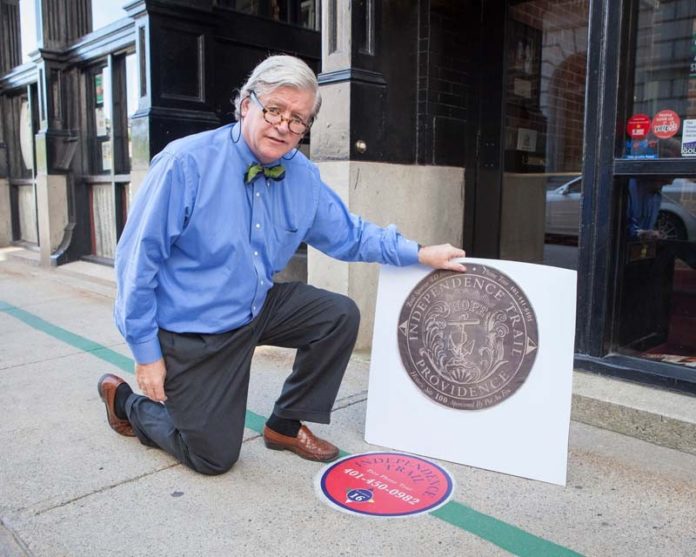
Rhode Island’s Independence Trail has all the makings of a major historic attraction, but there’s one thing it hasn’t got: an aura of permanence.
Like Boston’s Freedom Trail, Rhode Island’s way-finding path to historic landmarks covers 2.5 miles and connects visitors to the path and historic sites with emblems, or markers on the ground.
“They’ve made their trail significantly more permanent than ours by way of putting bronze emblems in granite,” Independence Trail founder Bob Burke said. “And they’ve replaced the painted line, which wears off, with brick, which is as permanent as you can get.”
What makes the Independence Trail, which follows a green-painted line, different is a phone number on every plastic emblem, along with the designated number for any of 50 landmarks. Visitors call to hear a free recording about a landmark’s history via their cellphone.
Those plastic emblems, says Burke, have seen better days.
Burke, who runs the Independence Trail Education Foundation, is launching a $50,000 fundraising campaign for new bronze emblems that he hopes to complete by the end of the year. Investing the money from individuals, companies and foundations would pay dividends, he says, particularly if the emblems are installed sometime this coming spring.
“That’s the kind of pride we need to start showing if we’re going to get more tourists to come and spend money,” said Burke, the owner of Providence’s Pot au Feu restaurant. “We want the emblems to be equivalent to the quality of our history, because the quality of our history is top-notch.”
Burke believes the ambitious Rhode Island project, which became a usable historic trail in the summer of 2011, has the potential to draw much more than the tens of thousands of visitors it has to date.
Martha Sheridan, president and CEO of the Providence Warwick Convention & Visitors Bureau, supports Burke’s effort to better establish the Independence Trail as a fixture in the minds of residents and tourists alike.
“Providence’s rich history is one of its greatest assets and historic and cultural tourism is a lucrative segment of the tourism economy,” Sheridan said in an emailed statement. “The Independence Trail is a cohesive way for visitors to hear the story of our city’s origins. Having these stops clearly and indelibly delineated would certainly help us as we market the destination.”
Installing the bronze emblems, which have been designed by Roll Barresi & Associates, a design firm based in Cambridge, would complete the second phase of the project. Historic and educational programming in 2014 and beyond would follow.
The way the Independence Trail works is for visitors to stop at an emblem, dial the phone number on it, and then report the historic landmark’s designated number to get a recording of history narrated by Burke. Both the phone number and the landmark number are embossed on each emblem, which is about 15 inches wide, Burke said.
The narratives encompass stories about Native Americans, the Colonial era, the Revolutionary War, waves of immigration, the Gilded Age, and the nation’s and world’s major conflicts.
Next year, a third programming phase will focus on fundraising as well. Burke hopes to develop programs for school teachers and students, tourists and civic groups. •












